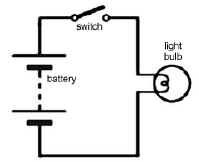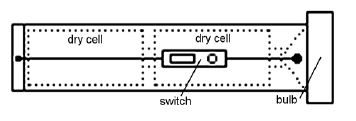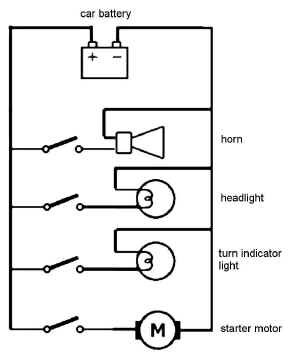 |
 |
| A simple series circuit |
What�s inside a flashlight |
The source in a flashlight is two series-connected dry cells, each having about 1.5 volts, to supply 3 volts to the circuit. A 3 volt bulb is the load, and a slide switch is connected between the source and load. The conducting path here is supplied by a metallic strip along the inside of the tube holding the batteries. When the switch is open, no current flows and the lamp is off. When the switch is closed, a complete path exists and current flows through the circuit, lighting the lamp. The current heats the filament of the lamp, and it emits light as well as heat.
 |
Another common example of a series circuit is the series string of Christmas tree lights (some types of small, "twinkle" lights). The disadvantage of such an arrangement is that if one lamp burns out, the electrical path is broken and all the other lights go out. A recent development is a lamp that, once burnt out, becomes a short circuit; it offers zero resistance to a current. The dead lamp acts like a piece of wire and the rest of the lamps remain lighted. All the remaining lamps, however, will now have a little more voltage across them, and more current will flow in the whole circuit. The total power consumed in such a circuit is the sum of the individual powers used in each lamp. |
| Schematic of series Christmas lights |
Parallel CircuitsA parallel circuit is one in which all the loads work at the same voltage as the source and independently of one another. If one load is switched off, the rest are unaffected. The electrical system in an automobile is an example of a DC parallel circuit in which the 12 volts from the battery simultaneously supplies electrical energy for the ignition system, headlights, taillights, and radio. If another load is added in a parallel system, it supplies another path for the current, so the total current needed from the source increases. The combined resistance of the parallel circuit effectively decreases whenever another load (resistance) is added in parallel. As in a series circuit, in a parallel circuit the total power is the sum of the individual powers required. Why Are You Being Told All Of This?Because...practically everything in a television station runs on electricity. Virtually everything in the technical side of television is a circuit. The concept of a circuit "path" is one that should be kept in mind when dealing with all the station's functions. Remember: |
 |
|
Automobile electrical system (your vehicle, hopefully, is not quite as simple as illustrated!) |
All equipment needs a "signal path" through which it gets video and/or audio, sends it on its way again, and gets control information from other devices and remote panels.
All television transmission is an extension of this signal path concept. We send it, it gets received. We can even see that it's receivable using our own off-air monitors.
All AC wiring in the facility is a network of series and parallel circuits. If you plug a light into the wall, you've created the simplest of series circuits. If you plug two lamps into the same duplex wall outlet, you've created a parallel circuit - made up of two series circuits, of course.
Most circuits convert electricity into another form of energy.
They have four main components. What are they?
There are series and parallel circuits. Can you compare and contrast the two types?
Why is this information important to us as TV people?